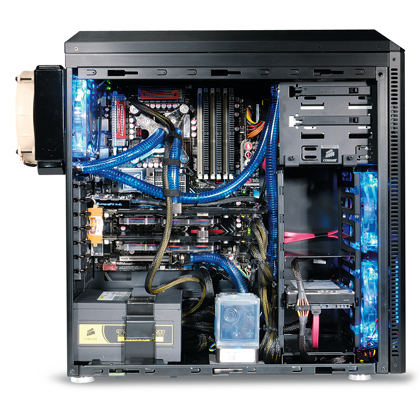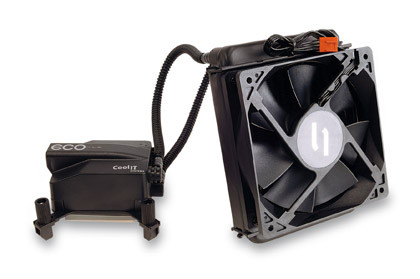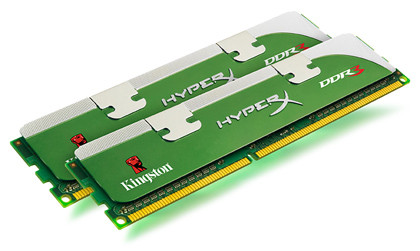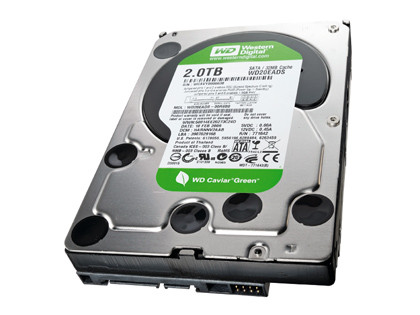Green PC or powerful gaming? How to get both
Can we mod our gaming system to be capable yet green?

The world of gaming systems is driven by the expressions of power. It's all swirling graphics and butch names, usually from Greek mythology. All a little adolescent really.
Now, however, being green is becoming sexy in an odd sort of way. It shows you care and can get you chicks (tongue + cheek).
Of course, big business has always been interested in low-power consumption; mainly because it saves money. Now the target of economy has been repackaged and resold as green to the rest of us, with all the moral overtones that entails.
It's no longer a dull business machine; it's a shiny green eco-model with logos to prove it. Sorry if this sounds cynical, it's our job to be. Whether you are a full-blown believer in the impending doom or not, there is an awful lot of being 'green' which doesn't wash well.
That games system you covet, replete with monster GPU, power supply and over-specified everything else with pleasing LED glowy bits, has started to look a little irresponsible - similar to huge 4x4s, flying to Switzerland for the weekend, heated swimming pools and all the other things that used to be merely decadent, not morally reprehensible. Can we have our cake and eat though?
Obviously we are not going to stop playing games, that's just crazy talk.
Power consumption of all
Get daily insight, inspiration and deals in your inbox
Sign up for breaking news, reviews, opinion, top tech deals, and more.
How much power does your PC use? And don't think the number on the PSU has anything to do with it, that's just the absolute maximum the power supply can manage reliably.
Armed with a plug-in energy monitor (about a tenner from Maplins) we took two systems from opposite ends of the power curve and had a look.
First, we tried an unassuming Dell business machine running a Celeron, which had Intel integrated graphics. During boot it peaked at 109W then settled down to 67W at the Windows desktop. We gave it a few meaty tasks, but couldn't get it to use more than 120W, thrashing the hard drive had the biggest effect. Meanwhile, setting the machine into standby mode it consumes only 3W.
Next, we tried something tasty running on a high-end motherboard. We know it is high-end because it has pointless lights and flashy fins all over it. Graphics came thanks to a ludicrously large and hot Radeon 5970. Booting peaked at 250W and even doing nothing much in particular at the desktop it consumed a healthy 170W.
Start running a DirectX 11 benchmark and it jumps to 200W as the 2.0TB hard drive spins up. When the 3D really started to do its stuff, it topped out at over 350W. This is a big beast of a rig, and even on standby it managed to be greedy at 9W.
These don't compare terribly well with the new generation of Green PCs especially developed and sold with their green credentials to the fore. A typical example consumes about 30W at the desktop. The question is: can we modify our gaming system to be both capable and green?
What can I save?
Some quick calculation on watts and prices reveal that saving money – and money is power – isn't going to be easy. The trouble is that electricity is just so cheap relatively speaking. Just twelve pennies will run an average PC for about ten hours.
The only reason you might grumble at your electricity bill is that we've all been seduced into buying loads and loads of electrical items and then using them all the time, like the wasteful beasts we are, instead of being content with candles and mangles.
How much can you actually save by cutting your PC's power consumption? Taking peak rate at 12p and running your PC for an average of five hours a day, every day for a year, and having shaved 10W off its power consumption, saves… wait for it: £2.20. Which sounds, er, spectacularly mediocre. Still, it's a start. And if everybody did it, it would be a goodly thing to do.
Running though the options for the major components we start with…
Processor
Chips can be pretty power hungry at full blast. If you look at your processor specifications you'll find the TDP, Thermal Design Power, which is quoted in watts. For desktop chips this runs from about 45 to 140W.
This isn't the power consumption though, it's the maximum heat dispersion required, and it is an absolute maximum too, it's useful only as a rough guide. Actual power consumption can be tricky to ascertain, as it is dependent on what your system is doing.
Modern processors are pretty good at throttling back and switching off cores, so picking a high performance one won't necessarily mean a such a huge increase in overall power consumption. Bare in mind that when idling CPUs can drop to as little as 10W. The more energy efficient chips tend to be the more mature designs running on a smaller process.
Many older designs now appear in low voltage flavours. Intel has a 1GHz Pentium M which has a TDP of just 7W. Nice, but it's not quite got the oomph we'll want.
AMD's top Phenoms come in at 140W TDP, but drop to 125 or even 95W fairly quickly. Even relatively new chips such as the Deneb core Phenom II have low power 'e' versions. The Phenom II X4 910e offers 2.6GHz four core fun at 65W.
Top choices from Intel include the Clarksfield-based i3s which run at 73W. Basically if you want power you pays the watts.
Since the point of this piece is keeping the power while trying to be green there is no point suggesting you cripple such an important component. That said, if the choice is between two chips at the cusp of the TDP categories, well lower might not hurt.

As for cooling: a typical fan might consume six watts or so and be able to idle at less, not much really. Going passive will save you that, of course, and all those copper pipes and aluminium fins look dead cool [Could you sound any older? – Ed].
But this on it's own isn't going to save you that much, and passive cooling can introduce all kinds of problems.
Memory
PC memory uses about 8W a stick for 1.8V. The simple way to reduce power is to reduce the voltage, which has been dropping steadily anyway. DDR started out at 2.5V, DDR2 at 1.8V and DDR3 at 1.5V. DDR4, due anytime 2012ish, should start out at running at 1.2V. Fitting fewer larger sticks doesn't hurt either as long as you keep your channels populated.

In the meantime we have low voltage DDR3 modules appearing which can run at as low as 1.25V. These are a trifle expensive though and quite frankly unless you are running some sort of server farm aren't worth the special investment. When the low voltage sticks become readily affordable then it is an obvious way to shave off some watts.
If you've been toying with the idea of fitting more memory though then go for it, as this will stop Windows hitting the swap file as much and spinning up the hard drive. Talking of which, we move onto…
Hard drive
Power and consumption here is pretty much directly linked to the spin speed, access time and the capacity. A typical drive burns between 10 to 15W at full chat and half that at idle. Obviously two drives means more power, so always go for one big drive.

There are a few clever things the manufacturers can do here, and are beginning to. Hitachi has a new energy efficient Deskstar range, which still runs at 7,200rpm but manages under 5W at idle and an impressive 7W or so at full bore. The price paid is sluggish access times, over 18ms, and like going back to 90s.
Western Digital has released what it terms its 'GreenPower' series, which runs at a more leisurely 5,200rpm and boasts a reduction of four or five watts. A saving, but again performance takes a hit.
What is clear from these greener drives is that you don't get owt for nowt. There is just not enough wriggle room to make significant saving without reducing performance.
How about solid state drives then? No motor to spin here. We were expecting some savings, and were disappointed.
Using our high-end test system we swapped out the 2.0TB traditional drive and fitted a 40GB SSD. Power consumption at the desktop dropped from 170W to 162W, putting a heavy load on the drive it managed a tad over 185W against around 200W. A saving, but nothing spectacular.
In fact one of the major disappointments of SSDs, particularly for laptops, is the minimal power savings, when compared to 2.5-inch laptop drive there's not much in it. The trouble is when SSDs are active they always draw their maximum power, unlike traditional drives, which only use maximum power when moving rapidly.
It's a developing technology though, and power saving modes have yet to be sorted out. Perhaps somebody could have a word with Microsoft about the way Windows seemingly insists on hammering the drive at every opportunity. But now for the real culprit…